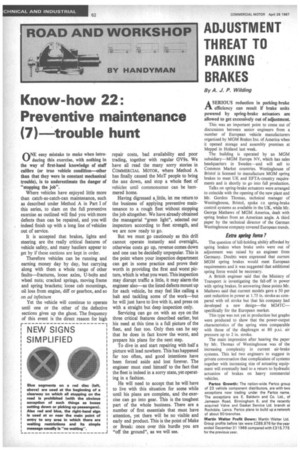Know-how 22: Preventive maintenance (7)--trouble hunt
Page 64

If you've noticed an error in this article please click here to report it so we can fix it.
rINE easy mistake to make when intro
ducing this exercise, with nothing in the way of first-hand knowledge of staff calibre (or true vehicle condition—other than that they were in constant mechanical trouble), is to underestimate the danger of "stopping the job".
Where vehicles have enjoyed little more than catch-as-catch-can maintenance, such as described under Method A in Part I of this series, to slam on the full preventive exercise as outlined will find you with more defects than can be repaired, and you will indeed finish up with a long line of vehicles out of service.
It is accepted that brakes, lights and steering are the really critical features of vehicle safety, and many hauliers appear to get by if these sections are kept in order.
Therefore vehicles can be running and earning money day by day, but carrying along with them a whole range of other faults—fractures, loose axles, U-bolts and wheel nuts; cracked springs, moving frame and spring brackets; loose cab mountings, oil loss from engine, diff or gearbox, and so on ad infinitum Yet the vehicle will Continue to operate until one or the other of the defective sections gives up the ghost. The frequency of this event is the direct reason for high
repair costs, bad availability and poor trading, together with regular GV9s. We have all read the many sorry stories in COMMERCIAL MOTOR, where Method A has finally caused the MoT people to bring the axe down, and stop a whole fleet of vehicles until commonsense can be hammered home.
Having digressed a.little, let me return to the business of applying preventive maintenance to a rough fleet without stopping the job altogether. We have already obtained the managerial "green light", selected our inspectors according to fleet strength, and we are now ready to go.
But we must go cautiously as this drill cannot operate instantly and overnight, otherwise costs go up, revenue comes down and one can be decidedly unpopular. This is the point where your inspection department can get in some practice and prove their worth in providing the first and worst picture, which is what you want. This inspection may disrupt traffic a little, it may alarm the engineer also—as the listed defects mount up for each vehicle, he may feel like calling a halt and tackling some of the work—but he will just have to live with it, and press on with a straight but deep inspection only.
Servicing can go on with an eye on the three critical features described earlier, but his need at this time is a full picture of the fleet, and fast too. Only then can he say that he does in fact know the worst, and prepare his plans for the next step.
To dive in and start repairing with half a picture will lead nowhere. This has happened far too Often, and good intentions have been forced aside and lost forever. The engineer must steel himself to the fact that the fleet is indeed in a sorry state, yet operating in a fashion.
He will need to accept that he will have to live with this situation for some while until his plans are complete, and the exercise can go into gear. This is the toughest part of the whole business. There are a number of first essentials that must have attention, yet there will be no visible and early end product. This is the point of Make or Break: once over this hurdle you are "off the ground", as we will see.
















































































































































































